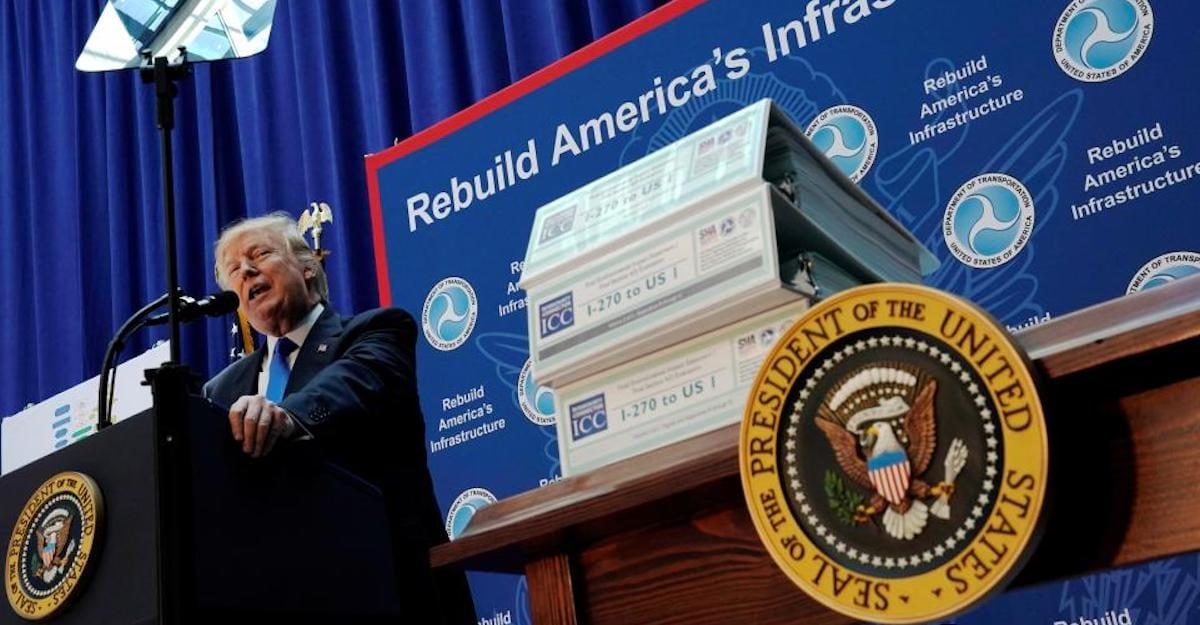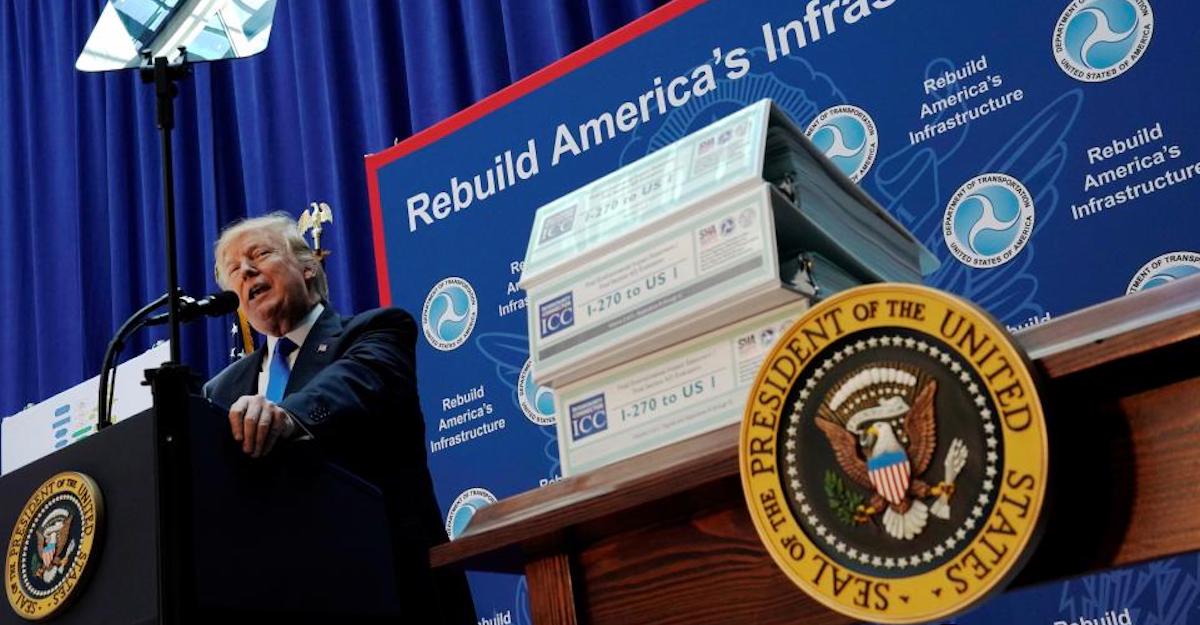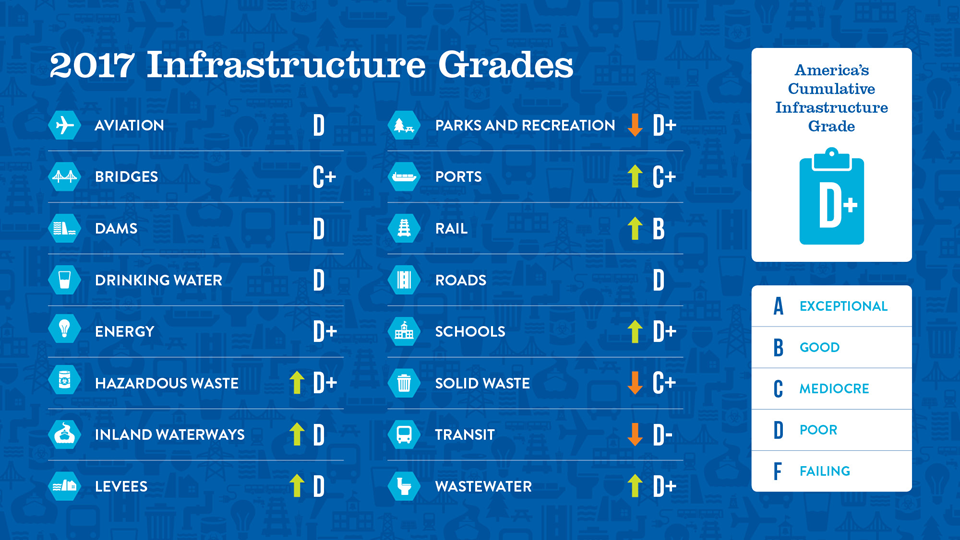

U.S. President Donald Trump delivers remarks on infrastructure improvements, at the Department of Transportation in Washington, U.S. June 9, 2017. (Photo: Reuters)
Multiple studies agree U.S. infrastructure is crumbling and the cost involved to repair it could pale in comparison to the cost of doing nothing.
President Donald Trump unveiled a $1.5 trillion proposal to rebuild the nation’s infrastructure through public-private partnerships. The first principle doesn’t call for Congress to write a check for that amount, but instead calls for $200 billion in federal funds to spur at least $1.5 trillion in infrastructure investments with partners at the state, local, tribal and private level.
Let’s take a look at where it stands now.
The World Economic Forum’s Global Competitiveness Index ranks the infrastructure competitiveness of the U.S. 11th out of 138 global economies. In terms of relativity, it doesn’t sound all that bad. But the rest of the world isn’t an impressive relative standard to use.
The American Society of Civil Engineers (ASCE) gave the U.S. a cumulative D+ GPA in 2017, though 7 subcategories showed improvement and 3 further deteriorated.

Source: American Society of Civil Engineers (ASCE)
Considering roads and bridges are at the forefront of the debate on the state of U.S. infrastructure, they are good subcatoriges to start with. But by no means are they the only two worthy of debate.
Roads Grade: D
According to the 2016 Trip Report, nearly one-third (32%) of the roads in the nation’s major urban areas – or, highways and major streets that are the main routes for commuters and commerce – are in poor condition. These stretches carry 70% of the approximately 3.1 trillion miles driven annually in America.
Including major rural roads, just 20% of the nation’s major roads are in poor condition, 39% are in mediocre or fair condition, and 40% are in good condition.
The ACSE found than 2 out of every 5 miles of America’s urban interstates are congested. Traffic delays cost the country $160 billion in wasted time and fuel in 2014, including an increase of $3.1 billion in extra gas used, alone.
The Texas A&M Transportation Institute’s 2015 Urban Mobility Scorecard estimates urban highway congestion cost the U.S. economy $160 billion.
And this will only get worse as the demand for transportation continues to increased, as it has along with volume and cost associated with road congestion since 2000. There was a 4.2% ($1,422.1 billion) rise in transportation demand from 2013 to 2014, the highest annual growth since the end of the December 2007 to June 2009 economic recession.
The Trip Report found motorists lose $523 annually because of the costs associated with driving on roads that need repairs.
Bridges Grade: C+
Nearly 4 in 10 (39%) of the 614,387 total bridges in the U.S. are 50 years or older. The average age of a bridge in the U.S. is 43 year sold, but most of them were designed for a lifespan of 50 years.
While an average 188 million trips are made across them each day, a whopping 56,007 (9.1%), or 1 in 11 of the nation’s bridges were structurally deficient in 2016. The good news is that this number is declining. The bad news is that most recent estimates peg the backlog rehabilitation costs at $123 billion.
The percentage of bridges that are structurally deficient can vary significantly by state, ranging from 1.6% in Nevada to 24.9% in Rhode Island in 2016.
Levees Grade: D
Nationwide, there are 30,000 miles of levees protecting critical infrastructure, communities and other properties. The U.S. Army Corps of Engineers (USACE) Levee Safety Program protects over 300 colleges and universities, 30 professional sports venues, 100 breweries, and an estimated $1.3 trillion in property.
The USACE says levees can be found in 35% of counties in the U.S. and nearly two-thirds of Americans live in a county with at least one.
They will need an estimated $80 billion over the next 10 years for maintenance and improvement, alone. Most of the levees across the nation were built in the middle of the last century by federal, state, and local agencies or by private property owners. The average age of a levee in the U.S. is 50 years old.
The USACE completed a risk assessment on over 1,200 levee systems out of the 2,500 in the safety program. It found that of USACE-owned levees, 5% are high to very high risk, 15% moderate risk, and 80% low risk.
In 2014, the U.S. Congress passed the Water Resources Reform and Development Act, which was intended to expand the levee safety program. However, it has yet to receive any funding.
Dam Grade: D
There are 90,580 dams in the country and the average age for them is 56 years old. By 2025, 7 out of 10 dams in the U.S. will be over 50 years old.
In 2016, the overall number of high-hazard potential dams increased to nearly 15,500. The number of deficient high-hazard potential dams also increased to an estimated 2,170. Another 11,882 dams are currently labeled as significant hazard potential. A failure for these would not necessarily result in a loss of life, but it’s believed the result would be significant economic losses.
The Association of State Dam Safety Officials estimates the total cost to rehabilitate non-federal and federal dams is at least $64 billion. To rehabilitate just those dams categorized as most critical, or high-hazard, would cost the nation nearly $22 billion, a cost that continues to rise as maintenance, repair, and rehabilitation are delayed.
The U.S. Army Corps of Engineers estimates that more than $25 billion will be required to address dam deficiencies for Corps-owned dams.
It is estimated that it will require an investment of nearly $45 billion to repair critical, aging, high-hazard potential dams. President Trump’s public-private partnership principle is key with dam infrastructure projects. According to the Association of State Dam Safety Officials, only 14% of dams in the U.S. are owned or regulated by government agencies.
Transit: D-
Transit expanded to 10.5 billion trips in 2015, a 33% increase from 20 years ago. But the rehabilitation backlog cost grew to $90 billion. The most recent data available show 10% of the nation’s urban bus fleet and 3% of the nation’s rail fleet are not in a “state of good repair.”
Physical infrastructure is in even worse shape. Fifteen percent (15%) of facilities such as maintenance facilities, 17% of infrastructure systems (i.e. power, signal, communications, fare collecting), 35% of guideway elements (i.e. tracks) and 37% of stations are not in a “state of good repair.”
Demand for public transit continues to rise. While 81% of Americans live in urban areas, the ASCE notes that only 51% of U.S. households reported in 2013 they could get to a grocery store using public transportation.








Alexa Joy / February 13, 2018
Yeah because those shovel ready projects never happened. Obama was gonna fix that from the start no… https://t.co/xJyhZWjRK4
/